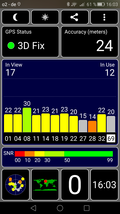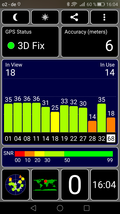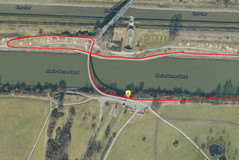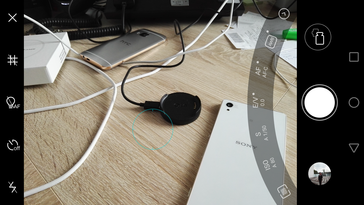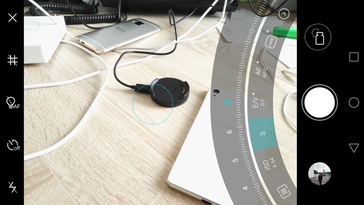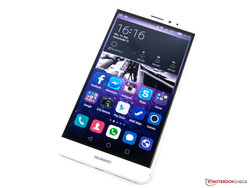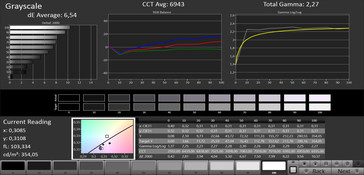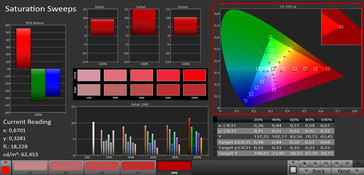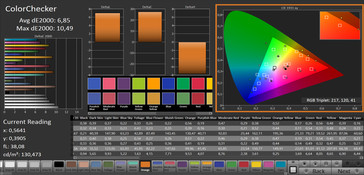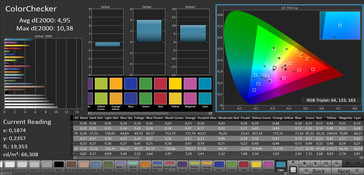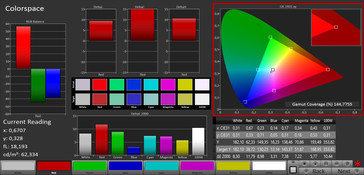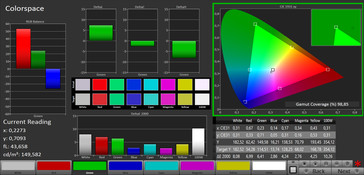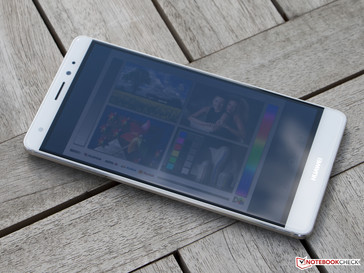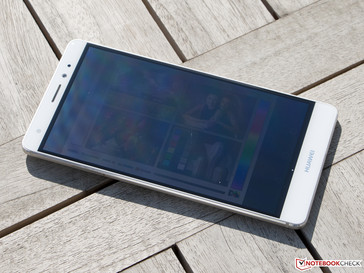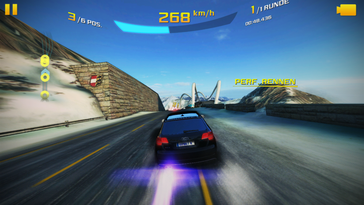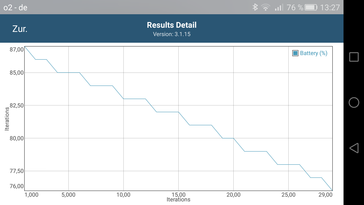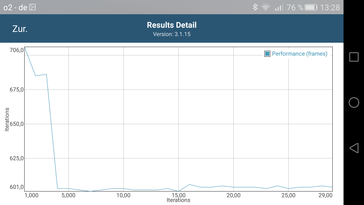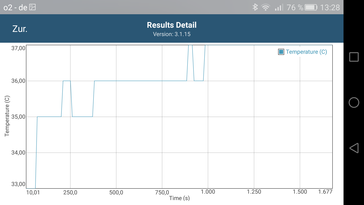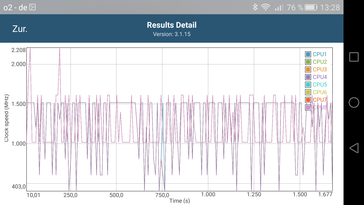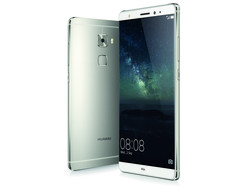Huawei Mate S Smartphone Review

For the original German review, see here.
With its Huawei P8, the Chinese company has already proven that it can build beautiful smartphones. It even goes a step further with its Mate S. The review sample is not the successor of the Mate 7, but is a sister model within the Mate series. A Huawei 8 is also planned.
The Mate S was unveiled to public at this year's IFA (international consumer electronics exhibition) in Berlin, and is the very first smartphone to feature a Force Touch surface, or as Apple calls it 3DTouch. Unfortunately, the first devices will be delivered without this technology. However, according to Huawei, corresponding models are to be shipped to Europe this year, and they will not to be limited to only the 128 GB model.
Three storage versions will be available. The 32 GB version is sold in the Titanium Gray and Mystique Champagne colors at a price of 649 Euros (~$725). A premium version with a 64 GB flash memory in Prestige Gold or Coral Pink costs an extra 50 Euros (~$56). Prices and availability of the 128 GB smartphone are not yet fixed. The latter will probably not be launched in Europe.
The price is considerably higher than that of Huawei's P8 flagship (RRP 499 Euros/~$558), which is probably due to the high-quality materials. At 5.5 inches, the Mate S is also somewhat larger. We have selected the OnePlus 2, Honor 7, Apple iPhone 6 Plus, Samsung Galaxy S6 edge+, and LG G4 from this category for comparison.
Case
The casing of Huawei's Mate S outer edges is just 2.65 millimeters (~0.1 in). The manufacturer specifies a height of 7.1 millimeters (~0.28 in), but we measured 7.7 millimeters (~0.3 in) at the tallest part, and it is even 8.3 millimeters (~0.33 in) with the protruding camera. However, this does not mar the excellent first impression. Quite the contrary: Due to its curved back, the slim smartphone is very pleasant to hold, the extremely slim edges make it look slimmer than it actually is and with a weight of 156 grams (~5.5 oz) it is not too heavy. Including the cover, the total package adds up to 199 grams (~7 oz).
The build is almost immaculate. The device's aluminum feels good, and the gaps are even and underline the high claim of the Mate S. The only minor drawback of the smartphone is its SIM card slot, which does not close quite flush with the rest of the casing's frame. However, it will be difficult to find something comparable in terms of quality on the market at the moment. Corning Gorilla Glass 4 protects the screen, and even high pressure or more vigorous warping attempts do not impress the Mate S.
We also like the narrow bezel, and only LG's G4 does a marginally better job here. The battery is not removable, but the storage can be expanded. Furthermore, the Mate S features a nano-coating that protects it against splash water. Our preliminary device is a single SIM model that accommodates only one nano-SIM card.
Connectivity
Considering its high price, the connectivity of Huawei's Mate S could be slightly more extensive. Although a modern octa-core processor with 3 GB of RAM is installed, it lacks some connectivity features that are found in the competition's flagship models. The single-band Wi-Fi supports Wi-Fi Direct, but not Miracast. DLNA, Slim Port and MHL are not supported, either. This makes it difficult to display the smartphone's content on a large monitor. Furthermore, an infrared sensor is not incorporated.
On the other hand, the storage can be expanded to 128 GB via a micro-SD card. Moving apps was easy. Furthermore, the micro-USB 2.0 port supports OTG, which allows connecting input devices via an optional adapter in addition to external storage devices.
Software
Huawei's Mate S is based on Google's Android 5.1.1 Lollipop operating system. It is covered with the known EMUI 3.1 interface. The looks of the proprietary UI has not changed compared with the Honor 7 or Huawei P8, and it runs very smoothly.
Communication & GPS
On the move, Huawei's Mate S accesses the Internet via HSPA+ or LTE Cat. 4 (max. 150 MBit/s). The good reception qualities and wide frequency coverage is positive. Unfortunately, the faster Cat. 6 or Cat. 9 standard are not supported.
The manufacturer also seems rather tight-fisted in terms of Wi-Fi, and does not utilize the 5.0 GHz frequency band. However, the transmission properties in the 2.4 GHz network are very good. The range is extremely high, and we could even stream an HD video at a distance of about 20 meters (~66 ft) from the router (Fritz!Box 6360) without interference. We were still connected to the router at a distance of 50 meters (~164 ft), but experienced periodic time outs. That was also only possible when the Wi-Fi+ option was enabled. This feature should actually help the smartphone switch between Wi-Fi and mobile network connection intelligently. However, it did not convince us because it did not always function reliably and appeared to favor Wi-Fi. The subjective power consumption also seemed higher.
Bluetooth 4.1 is also on board, and made a very good impression. The Mate S also presented a high range and stable connection here. There were never any interruptions in audio streaming during the test, not even when a smartwatch was additionally tethered to the phone. Even connecting with the car information system (Volkswagen) was fast and uncomplicated.
In the indoors, Huawei's Mate S had difficulties finding satellites and we often had to go to a window for a moment to prompt it. In the outdoor, positioning was very quick and accurate.
We checked the tracking accuracy in a comparison with the Garmin Edge 500 bike computer on a short bike trip. The bike navigation system recorded the route with a much higher accuracy while the smartphone seemed disposed to take shortcuts. The total route difference is about 3%. Although this is sufficient for everyday use, other devices do a better job.
Telephone & Call Quality
Compared with the P8 or Honor 7, the phone app has not been modified. The call quality of Huawei's Mate S is excellent. Whether the smartphone is held to the ear or the speaker is used, the device is always convincing and delivers a very good acoustic experience. The call is transmitted loud and clear when held to the ear. Furthermore, ambient noise suppression functions quite well.
The included headset also presented itself as surprisingly good. It reduces the noise of wind well and has a good sound. Making calls with it was very pleasant, even if the Mate S performed better when held to the ear.
Cameras
Like in Huawei's P8, an 8 MP front-facing camera and a 13 MP lens on the rear are used in the Mate S. The technical specifications of the components are identical to those of the sister model. Thus, it seems reasonable that the same camera modules are installed. However, the lens in the Mate S protrudes out of the casing slightly and is protected by sapphire glass.
Despite the front-facing camera's fix focus, it shoots quite decent photos, and is sufficient for selfies and groufies. The latter are even better when using panorama mode, which allows capturing even larger groups in the picture.
The primary camera is also convincing, and delivers good results. The focus could be slightly better, but differences compared to superior cameras are only visible in blowups. The range of dynamics is decent, but the camera from Huawei cannot compete with premium models like LG's G4 or Galaxy S6. The HDR mode remedies this, but it has to be enabled manually. Although the low-light photos are slightly darker than those of the competition, the sharpness is considerably higher. The photo's brightness can be adjusted via a control on the screen during the shoot. This makes better-illuminated photos possible, which could however take its toll on the picture quality.
Light painting is also available in the Mate S. The manual mode is new, which allows setting exposure time, light sensitivity, white balance and type of focus among other things. Also new, the automatic document correction: The camera simply has to be held over the object, for example a business card, and the smartphone automatically shoots a picture of it and crops it for an ideal view. This functioned quite well in practice.
Videos are still only recorded in Full HD. UHD should be available in this price range; however, the recordings are quite good and convincing.
Accessories
The range of accessories included with Huawei's Mate S are relatively extensive. Besides a USB cable and the modular power supply, the smartphone is shipped with a flip case with a window and a high-quality looking headset. More cases are to follow.
Warranty
Huawei includes a 24-month warranty on its Mate S.
Input Devices & Handling
The 5.5-inch, capacitive touchscreen of Huawei's Mate S detects up to ten fingers simultaneously, and is protected by the latest Corning Gorilla Glass 4. The surface is pleasant to the touch and conveys a first-rate feel. Its accuracy is beyond reproach. A glove mode is also preloaded.
Unfortunately, the onscreen Android buttons cannot be faded out like in the Honor 7. However, swiping over it enables one-hand mode.
The virtual keyboard is similar to other Huawei models, and supports swiping and automatic word suggestion. Users who frequently use social networking will miss a button for the smiley gallery.
In addition to Google Now, voice control by Huawei is also on board. It functions in standby, but is currently only available in English. The detection speed was only average; Huawei needs to improve that a bit.
Then again, the fingerprint scanner on the rear of the Mate S is good. Not only does it unlock the device, but can also be used as a camera release, a touchpad for scrolling through the gallery or be used to open the notification center. The sensor functions very fast and accurately. It is just a bit awkward that the smartphone has to be picked up every time to unlock it.
Force Touch (3D Touch)
Force Touch was also touted during the presentation of the Mate S. Unfortunately, the devices featuring this extra layer will first be launched on the market in the last quarter of this year. We could, however, take a closer look at the Mate S with Force Touch and try it.
Huawei does not yet have many features available. It is possible to use the smartphone as a scale with some restrictions. The object to be weighed has to respond to the capacitive surface and weigh between 100 and 400 grams (~3.5 and ~14 oz). An orange was used during the presentation, and it functioned quite well. However, we do not see a practical aspect with such tight restrictions. In addition, Force Touch can replace the Android navigation bar. Common functions are performed reliably when tapping the corresponding area on the screen, without taking room on the screen. Furthermore, our preview device allowed opening apps directly by tapping different corners on the screen. Force Touch itself functioned very well here, but the diversity of features should be increased considerably before launch to provide a genuine benefit.
Display
The screen in Huawei's Mate S is 5.5 inches, and has a resolution of 1920x1080 pixels. This equates to a pixel density of approximately 401 ppi, and is razor-sharp. The absence of a higher resolution screen can be tolerated. We were surprised that Huawei relies on a Super AMOLED screen rather than the very good IPS NEO panel that was used in the Chinese manufacturer's flagship models to date.
The screen is supplied by Samsung and has a brightness of up to 374 cd/m². This rate is sufficient for an OLED panel, and is considerably brighter than, for example, the one in a Lumia 930. However, the Mate S cannot compete with the latest Super AMOLEDs in Samsung's own premium smartphones. Although they have a similar brightness, they can increase it even further via the ambient light sensor when required. The Mate S does not have this feature. The illumination of 87% is only average.
| |||||||||||||||||||||||||
Brightness Distribution: 87 %
Center on Battery: 352 cd/m²
Contrast: ∞:1 (Black: 0 cd/m²)
ΔE ColorChecker Calman: 4.95 | ∀{0.5-29.43 Ø4.79}
ΔE Greyscale Calman: 6.54 | ∀{0.09-98 Ø5}
Gamma: 2.27
CCT: 6943 K
| Huawei Mate S Mali-T628 MP4, Kirin 935, 32 GB eMMC Flash | LG G4 Adreno 418, 808 MSM8992, 32 GB eMMC Flash | Samsung Galaxy S6 Edge+ Mali-T760 MP8, Exynos 7420, 32 GB UFS 2.0 Flash | Apple iPhone 6 Plus PowerVR GX6450, A8, 64 GB eMMC Flash | Nokia Lumia 930 Adreno 330, 800 MSM8974, 32 GB eMMC Flash | OnePlus 2 Adreno 430, 810 MSM8994, 64 GB eMMC Flash | Huawei P8 Mali-T628 MP4, Kirin 930, 16 GB eMMC Flash | Honor 7 Mali-T628 MP4, Kirin 935, 64 GB eMMC Flash | |
|---|---|---|---|---|---|---|---|---|
| Screen | 19% | 22% | 32% | -38% | 24% | 17% | 17% | |
| Brightness middle (cd/m²) | 352 | 566 61% | 335.7 -5% | 519 47% | 275 -22% | 451 28% | 453 29% | 442 26% |
| Brightness (cd/m²) | 350 | 536 53% | 332 -5% | 496 42% | 278 -21% | 446 27% | 439 25% | 440 26% |
| Brightness Distribution (%) | 87 | 90 3% | 89 2% | 90 3% | 89 2% | 90 3% | 91 5% | 92 6% |
| Black Level * (cd/m²) | 0.47 | 0.62 | 0.3 | 0.28 | 0.23 | |||
| Colorchecker dE 2000 * | 4.95 | 6.17 -25% | 2.33 53% | 3.67 26% | 10.99 -122% | 3.84 22% | 4.7 5% | 4.52 9% |
| Greyscale dE 2000 * | 6.54 | 6.26 4% | 2.15 67% | 3.78 42% | 8.29 -27% | 3.97 39% | 5.03 23% | 5.47 16% |
| Gamma | 2.27 97% | 2.48 89% | 2.15 102% | 2.42 91% | 2.16 102% | 2.46 89% | 2.27 97% | 2.27 97% |
| CCT | 6943 94% | 8171 80% | 6184 105% | 7327 89% | 6731 97% | 7283 89% | 7439 87% | 7874 83% |
| Contrast (:1) | 1204 | 837 | 1503 | 1618 | 1922 | |||
| Color Space (Percent of AdobeRGB 1998) (%) | 65.48 | 58.07 | 72.04 | |||||
| Color Space (Percent of sRGB) (%) | 98.63 | 90.14 | 99.7 |
* ... smaller is better
The contrast ratio is virtually infinite owing to the installed Super AMOLED screen, and it is thus impeccable. Black is also pitch-black. The typical over-saturation is also seen in the Mate S. Unfortunately, there are no alternative color profiles to suit personal needs, such as in the Galaxy S6 (Edge).
The color reproduction looks very warm even subjectively. The measurements with the photospectrometer in CalMAN also confirm this. The grayscale levels exhibit a visible purplish tint. As usual, the color temperature can be adjusted in the settings .
Furthermore, the screen has a wide color space coverage, and thus the color reproduction is somewhat more accurate in AdobeRGB than in the smaller sRGB. However, very obvious shifts from the ideal can be ascertained and even exceed DeltaE 10. Thus, the screen in the Mate S is not suitable for color reference, but that will not be distracting in everyday use.
Huawei's Mate S is sufficiently bright for outdoor use, and primarily benefits from its great contrast ratio. We could usually recognize the content well in the autumn sun. Reflections on the glossy surface were occasionally annoying, but overall, the review sample fared quite well outdoors.
The viewing angle stability of Huawei's Mate S is very good, and colors do not invert even in very flat viewing angles - but that would have surprised us in view of the OLED panel. Only a minor decrease in brightness and a light greenish shimmer is perceptible in an angle from about 45 degrees.
Performance
A HiSilicon Kirin 935 SoC is installed in Huawei's Mate S. It is almost identical with the Kirin 930 in the P8, except that the 935 clocks up to 200 MHz faster. The SoC has two quad-core clusters with Cortex A53 cores. While the stronger cluster clocks at up to 2.2 GHz, the second only clocks at up to 1.5 GHz. 3 GB of working memory and an ARM Mali-T628 MP4 graphics unit supplement thatthis.
The performance is almost exactly 10 percent% higher than that of the Kirin 930, which is particularly evident in the Geekbench 3 single-core test. It is even 15 percent% when all cores are utilized. The higher performance is not as strongly noticed in 3DMark Ice Storm Unlimited, where a performance plus advantage of only four percent4% over the smaller unit are is achieved. However, the Kirin looks quite weak compared with present current top SoCs. The Galaxy S6 Edge (Exynos 7420) outruns the Mate S by whole 51 percent% in AnTuTu v5, and the OnePlus 2 (Snapdragon 810) is also considerably faster. Only the Edge is faster in PCMark, which underlines the review sample's everyday suitability because the UI runs very smoothly.
The storage speed of the Mate S is in the midfield among the high-end devices. We looked closer at the micro-SD slot, and tested its speed with the swift fast Toshiba Exceria SD-CX32UHS1 (UHS-I Class 3, read: 85 MB/s, write: 55 MB/s) memory card. The Mate S provided good transfer rates (read: 63.1 MB/s, write: 17.76 MB/s). It only showed performance weaknesses in writing small data blocks (0.1 MB/s).
The browser speed is also good, but the review sample has to take a place at the back compared to the contenderscompetition. The Mate S primarily lags behind extremely especially in the Java JetStream 1.1 test.

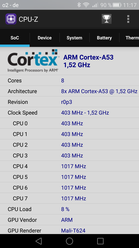
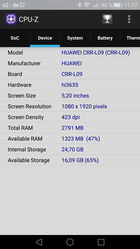
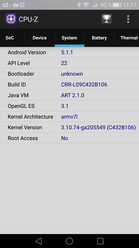
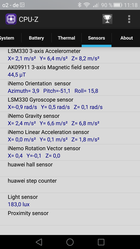
| AnTuTu v5 - Total Score (sort by value) | |
| Huawei Mate S | |
| Huawei P8 | |
| Honor 7 | |
| HTC One M9 | |
| Samsung Galaxy S6 Edge | |
| OnePlus 2 | |
| LG G4 | |
| Sony Xperia Z3+ | |
| Apple iPhone 6 Plus | |
| Geekbench 3 | |
| 64 Bit Single-Core Score (sort by value) | |
| Huawei Mate S | |
| Huawei P8 | |
| Honor 7 | |
| HTC One M9 | |
| Samsung Galaxy S6 Edge | |
| OnePlus 2 | |
| LG G4 | |
| Sony Xperia Z3+ | |
| 64 Bit Multi-Core Score (sort by value) | |
| Huawei Mate S | |
| Huawei P8 | |
| Honor 7 | |
| HTC One M9 | |
| Samsung Galaxy S6 Edge | |
| OnePlus 2 | |
| LG G4 | |
| Sony Xperia Z3+ | |
| PCMark for Android - Work performance score (sort by value) | |
| Huawei Mate S | |
| Huawei P8 | |
| Honor 7 | |
| HTC One M9 | |
| Samsung Galaxy S6 Edge | |
| OnePlus 2 | |
| LG G4 | |
| Sony Xperia Z3+ | |
| GFXBench (DX / GLBenchmark) 2.7 | |
| T-Rex Onscreen (sort by value) | |
| Huawei Mate S | |
| Huawei P8 | |
| Honor 7 | |
| HTC One M9 | |
| Samsung Galaxy S6 Edge | |
| OnePlus 2 | |
| LG G4 | |
| Sony Xperia Z3+ | |
| Apple iPhone 6 Plus | |
| 1920x1080 T-Rex Offscreen (sort by value) | |
| Huawei Mate S | |
| Huawei P8 | |
| Honor 7 | |
| HTC One M9 | |
| Samsung Galaxy S6 Edge | |
| OnePlus 2 | |
| LG G4 | |
| Sony Xperia Z3+ | |
| Apple iPhone 6 Plus | |
| Octane V2 - Total Score (sort by value) | |
| Huawei Mate S | |
| Huawei P8 | |
| Honor 7 | |
| HTC One M9 | |
| Samsung Galaxy S6 Edge | |
| OnePlus 2 | |
| LG G4 | |
| Sony Xperia Z3+ | |
| Apple iPhone 6 Plus | |
| JetStream 1.1 - Total Score (sort by value) | |
| Huawei Mate S | |
| Honor 7 | |
| HTC One M9 | |
| Samsung Galaxy S6 Edge | |
| OnePlus 2 | |
| LG G4 | |
| Sony Xperia Z3+ | |
| WebXPRT 2015 - Overall (sort by value) | |
| Huawei Mate S | |
| Huawei P8 | |
| Honor 7 | |
| HTC One M9 | |
| OnePlus 2 | |
| LG G4 | |
| Sony Xperia Z3+ | |
Games
The ARM Mali-T628 MP4 graphics unit in Huawei's Mate S is positioned in the performance midfield of mobile GPUs. It supports modern graphic standards, such as OpenGL ES 3.1. Even games with higher performance demands, like "Asphalt 8", are mostly rendered smoothly in maximum image quality. However, slightly more power will be needed in faster scenes where several vehicles are displayed.
The excellent touchscreen and impeccable functionality of the sensors make the Mate S a decent mobile game console. Unfortunately, in landscape mode, a hand can sometimes cover the speaker.
Emissions
Temperature
The surface temperatures of Huawei's Mate S are relatively low. The smartphone reaches a maximum of 31.2 °C (~88 °F) in idle with active screen, and it is at most lukewarm at 35.8 °C (~96 °F) under permanent load.
To assess the situation on the SoC, the Mate S had to face the battery test of GFXBench 3.1. The T-Rex test runs thirty times in succession, and records both the battery state and frame rates among other things. The performance dropped by almost 15% at the beginning of the third run, and settled at this level. The performance loss is not as significant as, for example, in HTC's One M9 (up to 40%), but that is not as tragic for the competition in view of its high performance since it still achieves approximately twice as many frame rates as the Mate S.
(+) The maximum temperature on the upper side is 35.8 °C / 96 F, compared to the average of 35.2 °C / 95 F, ranging from 21.9 to 247 °C for the class Smartphone.
(+) The bottom heats up to a maximum of 32.9 °C / 91 F, compared to the average of 34 °C / 93 F
(+) In idle usage, the average temperature for the upper side is 30.5 °C / 87 F, compared to the device average of 32.9 °C / 91 F.
Speaker
Although it might look as if Huawei's Mate S has two speakers on the lower edge, only one is hidden behind the right grille when held in the hand. Basses are virtually non-existent, but the trebles are rendered very well. The presented quality is comparatively good, and the sound is very balanced up to a volume of 60%. Trebles start to distort beyond that in music playback. However, it must be noted that the Mate S can be very loud.
A 3.5 mm audio jack is also installed. Media sounds quite decent with the included headset, but echoes slightly. Users who connect high-quality stereo headphones will be satisfied with the available performance. The integrated DTS mode audibly improves the headset's sound.

Energy Management
Power Consumption
The idle power consumption of Huawei's Mate S is somewhat lower than that of the P8 due to the OLED screen. This advantage is offset under load, probably because of the slightly stronger SoC. The full load power consumption is generally surprisingly high when put in ratio with the performance. Smartphones based on a Snapdragon 810 usually do not need more power. Furthermore, the standby power consumption is slightly increased.
| Off / Standby | |
| Idle | |
| Load |
|
Key:
min: | |
Battery Runtime
Although a relatively small battery is installed in Huawei's Mate S, it was very enduring in the test and excelled with outstanding runtimes. It outperformed its rivals in almost all fields.
Everyday use is also beyond reproach. The battery easily managed a day even when we extensively browsed through social networks, processed emails, used Messenger, and played a few games. A remaining capacity of over 40% was often displayed at the end of the day, even when a smartwatch was tethered to the Mate S.
| Huawei Mate S Mali-T628 MP4, Kirin 935, 32 GB eMMC Flash | Huawei P8 Mali-T628 MP4, Kirin 930, 16 GB eMMC Flash | Honor 7 Mali-T628 MP4, Kirin 935, 64 GB eMMC Flash | LG G4 Adreno 418, 808 MSM8992, 32 GB eMMC Flash | Samsung Galaxy S6 Edge+ Mali-T760 MP8, Exynos 7420, 32 GB UFS 2.0 Flash | Apple iPhone 6 Plus PowerVR GX6450, A8, 64 GB eMMC Flash | OnePlus 2 Adreno 430, 810 MSM8994, 64 GB eMMC Flash | |
|---|---|---|---|---|---|---|---|
| Battery runtime | -18% | -14% | -17% | -1% | 6% | -8% | |
| Reader / Idle (h) | 18.7 | 13.8 -26% | 14.8 -21% | 27.6 48% | 24.3 30% | 23.9 28% | 23.2 24% |
| H.264 (h) | 9.5 | 9.7 2% | 9.2 -3% | 8.4 -12% | 11.3 19% | 9.7 2% | |
| WiFi v1.3 (h) | 9.6 | 7.2 -25% | 8.1 -16% | 5.4 -44% | 8.4 -12% | 5.9 -39% | |
| Load (h) | 4.7 | 3.6 -23% | 4 -15% | 1.9 -60% | 3.7 -21% | 3.3 -30% | 3.8 -19% |
| WiFi (h) | 13 |
Pros
Cons
Verdict
Huawei's Mate S is a successful smartphone that primarily convinces with its outstanding build and stylish design. It provides great battery runtimes, a decent camera, first-rate call quality, and an up-to-date operating system in the form of Google's Android 5.1 Lollipop, which runs very smoothly.
However, we do not quite understand why Huawei charges 150 Euros (~$168) more for it than for its P8. Although the device makes a higher quality impression and twice the internal storage capacity as well as a faster SoC, buyers who opt for the premium P8 will more than compensate these advantages and even save 50 Euros (~$56).
Huawei offers a superb smartphone with its Mate S; however, its greatest drawback is its unusually high price.
It is also too bad that Force Touch is not available for the Mate S at launch. However, it is to be available in Europe this year. Huawei could not confirm whether that will affect the price. This feature increases the height by half a millimeter due to the extra layer over the touchscreen.
The greatest shortcoming is the somewhat limited connectivity. Neither LTE Cat. 6 nor an IR port is installed, and the interfaces for media playback are also relatively sparse. On the other hand, the Mate S is equipped with a very good fingerprint scanner, which has some extra features. Overall, the device is a great smartphone.
Huawei Mate S
- 09/16/2015 v4 (old)
Daniel Schmidt



















